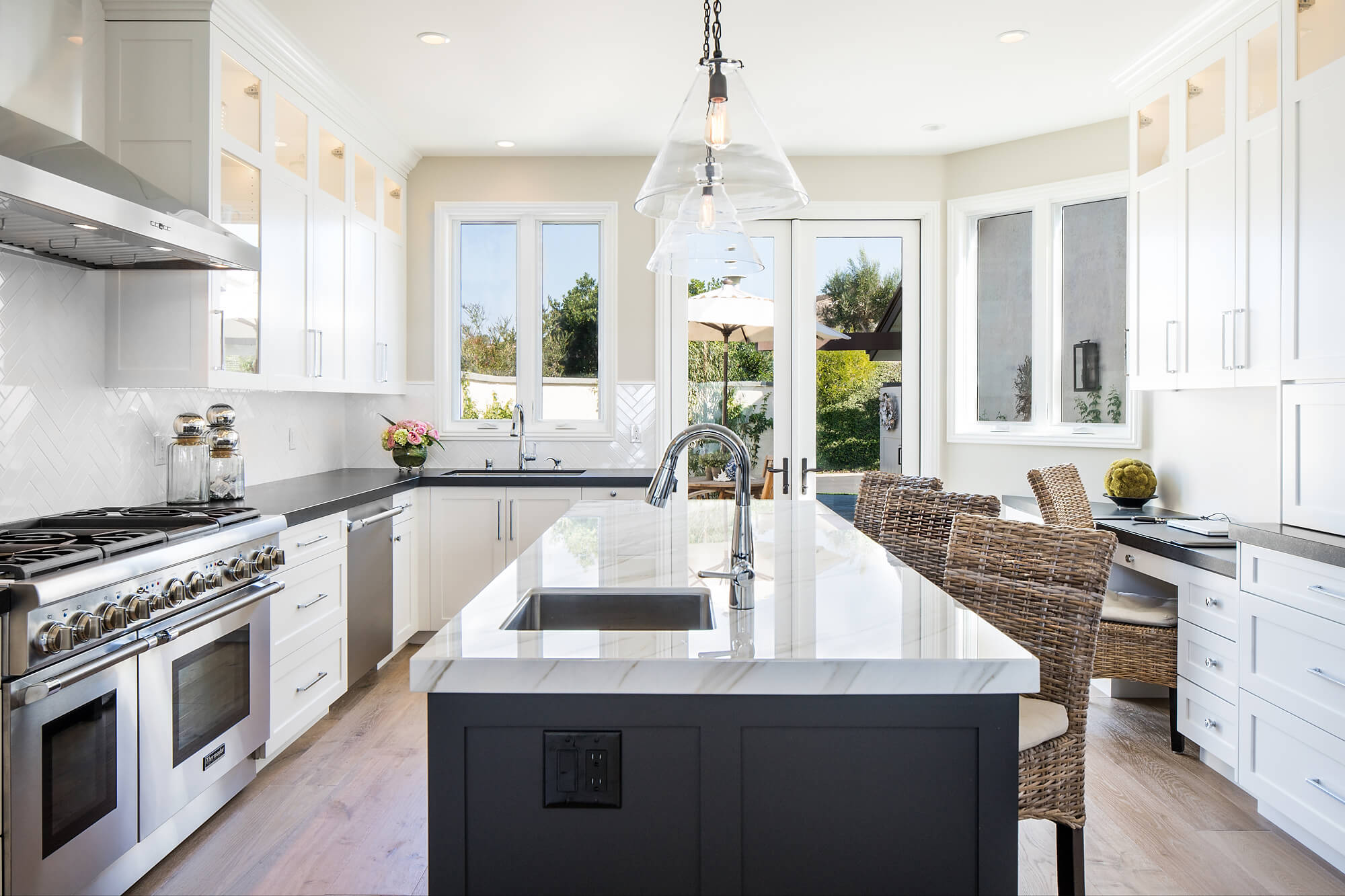
Homeowners should first evaluate their reasons for remodeling. A clear purpose helps guide decisions. Assessing current kitchen functionality is crucial. Initial budget planning ensures realistic expectations. Researching styles and trends provides inspiration. Considering resale value can influence choices. Engage with a professional early on for expert advice. These steps create a solid foundation for the project.

Remodeling the kitchen can significantly improve functionality. Homeowners often seek a modern look to enhance aesthetics. Upgrading can increase energy efficiency with new appliances. Often, a remodel addresses wear and tear issues. This home improvement project might also boost the property’s value. Additionally, a renovated kitchen can better meet the family’s evolving needs.
Here’s a table breaking down the average cost of remodeling a kitchen by line item. The costs can vary widely depending on the size of the kitchen, the quality of materials, and the location of the project, but these are general estimates:
| Line Item | Average Cost |
|---|---|
| Cabinetry and Hardware | $6,000 – $12,000 |
| Installation | $3,000 – $6,000 |
| Appliances | $3,000 – $8,000 |
| Countertops | $2,000 – $5,000 |
| Flooring | $1,500 – $4,500 |
| Lighting | $1,000 – $2,500 |
| Plumbing | $1,000 – $3,000 |
| Design Fees | $1,000 – $3,500 |
| Electrical Work | $1,000 – $2,500 |
| Painting | $500 – $2,000 |
| Windows and Doors | $500 – $2,500 |
| Miscellaneous | $500 – $1,500 |
| Permits and Fees | $500 – $1,500 |
Here’s a breakdown of the average cost per square foot for kitchen remodels based on the size and level of customization:
| Kitchen Size | Average Cost per Square Foot |
|---|---|
| Small (70-100 sq ft) | $100 – $250 |
| Medium (100-200 sq ft) | $75 – $200 |
| Large (200+ sq ft) | $50 – $150 |
| Level of Customization | Average Cost per Square Foot |
|---|---|
| Economy | $75 – $125 |
| Semi-Custom | $125 – $200 |
| Custom | $200 – $350 |
These estimates provide a more nuanced understanding of how costs can vary based on both the size of the kitchen and the level of customization involved. If you need more detailed information or further breakdowns, feel free to ask!

The cost of materials greatly influences kitchen remodeling budgets. Cabinets and countertops command a significant portion, ranging from affordable laminate to premium granite or quartz. Flooring and backsplashes also add to expenses. Quality, durability, and design preferences impact prices. Homeowners should compare different materials to balance aesthetics and budget. Strategic choices ensure cost-effective renovations.

Cabinets and countertops often take up the bulk of a kitchen remodeling budget. Homeowners can choose from various materials like laminate, granite, or quartz, each with different price points. The cost will depend on the material’s quality and design preferences. Comparing options ensures a balance between aesthetics and budget constraints.
Here’s a table breaking down the costs for different countertop choices, including their average cost per square foot:
| Countertop Material | Average Cost per Square Foot | Pros | Cons |
|---|---|---|---|
| Laminate | $10 – $40 | Affordable, variety of colors/designs | Less durable, can scratch or chip |
| Ceramic Tile | $5 – $30 | Variety of styles, heat resistant | Grout can stain, requires maintenance |
| Granite | $40 – $100 | Durable, heat resistant, natural beauty | Can be expensive, requires sealing |
| Marble | $50 – $150 | Elegant, heat resistant | Prone to scratching/staining, costly |
| Quartz | $50 – $150 | Durable, low maintenance, variety of colors | Can be expensive |
| Solid Surface | $35 – $85 | Seamless appearance, repairable | Can scratch, not heat resistant |
| Butcher Block | $35 – $200 | Warm, natural look, can be sanded | Requires regular maintenance, can stain |
| Stainless Steel | $70 – $200 | Modern look, heat resistant, durable | Can scratch, fingerprints show easily |
| Concrete | $65 – $135 | Customizable, heat resistant | Can crack, requires sealing |
| Soapstone | $70 – $120 | Heat resistant, natural patina | Can scratch, limited color options |
| Recycled Glass | $50 – $125 | Eco-friendly, unique look | Can be expensive, can chip |

Flooring and backsplash choices impact both the look and cost of a kitchen remodel. Materials like ceramic tiles and hardwood come at various price points. Homeowners should compare durability against budget constraints. Proper installation is crucial to avoid future costs. It’s wise to invest in quality materials that can withstand wear and tear over time.
Here is a table breaking down the costs for different backsplash choices, including their average cost per square foot:
| Backsplash Material | Average Cost per Square Foot | Pros | Cons |
|---|---|---|---|
| Ceramic Tile | $5 – $20 | Affordable, variety of styles, easy to clean | Grout can stain, requires maintenance |
| Porcelain Tile | $7 – $25 | Durable, resistant to moisture and stains | More expensive than ceramic |
| Glass Tile | $10 – $30 | Modern look, reflective, easy to clean | Can be slippery when wet, requires careful installation |
| Natural Stone Tile | $10 – $40 | Unique, natural look, durable | Can be porous, requires sealing |
| Marble | $15 – $50 | Luxurious, elegant look | Expensive, can stain or scratch |
| Stainless Steel | $20 – $50 | Modern, industrial look, heat resistant | Can scratch, shows fingerprints |
| Mosaic Tile | $10 – $40 | Versatile, decorative, various materials | Can be labor-intensive to install |
| Subway Tile | $7 – $25 | Classic look, versatile, affordable | Grout can stain, requires regular cleaning |
| Peel-and-Stick Tile | $5 – $15 | Easy to install, budget-friendly | Less durable, can peel over time |
| Quartz | $15 – $60 | Durable, non-porous, seamless look | Expensive, limited color options |
| Concrete | $10 – $30 | Customizable, durable | Can crack, requires sealing |
| Reclaimed Wood | $10 – $40 | Eco-friendly, rustic look | Can be difficult to clean, not moisture resistant |
| Copper | $20 – $50 | Unique, warm look, antimicrobial properties | Can tarnish, requires maintenance |

Hiring contractors for a kitchen remodel entails significant labor costs. Homeowners pay for expertise, experience, and efficiency. The complexity of the design influences these charges. DIY projects can save money but may risk quality and longevity. Accurate cost estimation involves understanding local labor rates and project scope. Labor costs can vary widely based on the region.

Hiring contractors ensures expertise and efficiency, often leading to higher quality results. Homeowners benefit from professional experience but can expect substantial labor costs. Opting for a DIY approach saves money, offering control over the process. However, it may compromise quality and extend project duration. Careful consideration of skills and time is essential before deciding.

Labor costs vary significantly based on project complexity. Geographic location also plays a role, with urban areas generally demanding higher rates. The skill level of the hired professionals impacts price as well. Additionally, unexpected complications during construction can increase labor expenses. Homeowners should anticipate potential delays and prepare for additional costs accordingly.
During kitchen remodeling, homeowners often overlook hidden expenses. Permit fees and inspection costs can add up quickly. Unforeseen structural issues, such as outdated wiring or plumbing, may require immediate attention. These unexpected problems can significantly inflate the overall budget. Homeowners should set aside a contingency fund to cover these hidden costs and avoid financial strain.
Homeowners often overlook permit fees and inspection costs when planning a kitchen remodel. These fees vary depending on the location and the scope of the project. Permits are essential to ensure the remodel complies with local building codes. Inspections verify the work is up to standard. Neglecting these costs can lead to fines or delays.

Unforeseen structural issues can significantly impact a kitchen remodeling budget. Examples include outdated wiring, plumbing problems, or hidden mold. These issues often remain undetected until the remodel is underway. Addressing them is crucial for safety and compliance. Homeowners should set aside extra funds for these unexpected challenges. Preparedness can prevent delays and additional costs.
An updated kitchen can substantially increase a home’s value. Buyers often prioritize modern kitchens, making it a smart investment. Factors like quality of materials and market trends affect ROI. A well-executed remodel can recover up to 80% of its cost. Homeowners should carefully plan to balance expenditure and potential returns.
An updated kitchen can significantly boost a home’s value. Potential buyers often prioritize modern and functional kitchens. Quality materials and smart design choices play a crucial role. A well-executed remodel can make the property more appealing and competitive in the market. This investment often pays off during resale, enhancing overall property worth.
Several elements impact ROI for kitchen remodeling. The quality of materials used is crucial; high-end options yield better returns. Design trends matter as well. Functional and modern layouts attract buyers. Local market conditions also play a role. A hot real estate market can amplify returns. Lastly, the remodel’s extent and execution quality affect outcomes.

Kitchen remodeling can be overwhelming, but careful planning helps. Set a realistic budget and prioritize needs. Consider both material and labor costs. Account for hidden expenses like permits. Quality workmanship increases ROI. Staying organized ensures the project remains on track. These steps lead to a successful kitchen remodel without financial stress.

Successful kitchen remodeling lies in thorough planning and budgeting. Prioritizing essential upgrades prevents overspending. Awareness of material, labor, and hidden costs is crucial. Hiring reputable contractors ensures quality work. Attention to detail minimizes unexpected expenses. Staying organized and flexible helps manage costs effectively. Thoughtful decisions lead to a beautiful, functional kitchen without financial strain.

Homeowners should prioritize essential renovations. Comparing quotes from different contractors is essential. Opting for mid-range materials can save money without sacrificing quality. Reusing existing appliances and fixtures helps cut costs. Monitoring expenses diligently ensures adherence to the budget. Lastly, allowing a contingency fund for unexpected costs is vital for financial preparedness.



